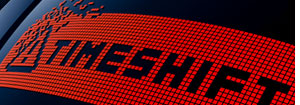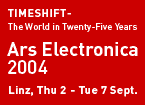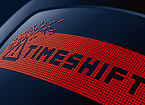| |
|
|
|
|
||
|
||||||||||||||||||||
|
 |
 |
||||||
 |
|||||
Ars Electronica 2004 For 25 years now, Ars Electronica has been tracking and nurturing the digital revolution, analyzing the social and cultural effects of digital media and communications technologies from critical as well as utopian, artistic and scientific perspectives, thinking them through and inferring potential developments. During this span of 25 years, Ars Electronica has also served as a logbook recording the development of new art forms and new artistic practices as well as the accompanying transcendence of boundaries to science and technology. The enormous archive that has taken shape as a result constitutes powerful testimony to the manifold currents and trends to which the interplay and friction between art and technology have given rise, and also documents Ars Electronica’s unique breadth as a discussion forum providing a staging ground for confrontation and dialogue, for provocation and bridge-building. The Prix Ars Electronica, the Ars Electronica Center and the Ars Electronica Futurelab are the consistent extensions with which we have continually expanded the radius of our activities. This is the course on which Ars Electronica embarked in 1979 and on which it has been joined by communities of cyberartists and digerati dispersed throughout the world. It has been like an annual expedition that blazes trails into new and barely chartered territories, gathering samples and artifacts as it continues on its journey through time, encountering milestones and signposts indubitably pointing the way as well as transient phenomena and experiments of uncertain outcome. Thus, bearing witness to contemporary developments and accumulating authentic experience have proven to be reliable methods for compiling a cartographic record of our media culture. Ars Electronica has also become a significant source of inspiration in the process of cultural and economic change that has been underway in this city. As a result, Linz has come to epitomize the model municipality whose orientation on the future is not just a question of commerce and industry, but rather one that is envisioned primarily as a cultural undertaking. This demonstrates the social relevance of artistic work and also serves as a prototype for urban renewal and cultural policy development options that go beyond traditionalism and tourism. “TIMESHIFT—The World in Twenty-Five Years” is the title of the 2004 festival; transformation, upheaval and the future are its programmatic concepts. The point of departure is reflection upon the past 25 years; the aim is to identify the developments that promise to be the driving forces in art, technology and society over the next quarter century. What will ignite the next generation’s potential energy for protest? What will fuel the forward mobility of the kids of the cybergeneration? Burghers of a networked civil society revolting against blanket surveillance by the state? Global communities aligned in opposition to the global economy? Climatic change and a hydrogen energy sector? An increasingly elderly society? Delimitation of migration? Fundamentalism and the fear of terrorism? The centers of information technology are shifting to India and China, but copious new developments will continue to provide thrust for a digital sector that is driven economically by global consumer markets and, of course, by the war and security industries as well. A glance at current stock market trends quickly reveals that nanotechnology is likely to become the most important key technology of them all and one whose impact will cut across the borders of all sectors and fields, for it is here that the laws of physics converge with chemical properties and biological principles. Nanotechnology transcends the boundaries between mechanics, information science, biology and chemistry. TechNouveau means the reverse engineering of nature, and completely new classes of materials give us good reason to expect a “reinvention of nature.” Not silicon but organic molecules will form the core of the ultra-fast computers of tomorrow. Molecular medicine, anti-aging, tissue culture, genetically modified foods and cloning are further stages in our assertion of power over nature—plenty of reasons to not lose sight of our rearview mirror. The constellation of issues making up this year’s theme will manifest itself in various formats and an array of venues: at symposia and talks with artists, in discussion forums and workshops, at exhibitions, installations and interventions in urban spaces, as well as at performances and concerts. Special events and guest presentations will be among the featured attractions of this year’s festival program.
|
| © Ars Electronica Linz GmbH, info@aec.at | |||||||||